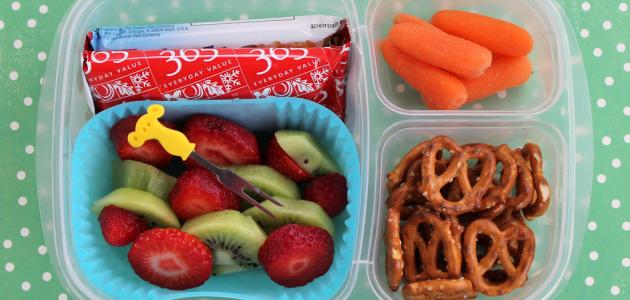Contents
Children's growth
The process of children's development during the first year of their life is rapid and intense in all aspects of the physical, cognitive, emotional, and psychological aspects, as well as their ability to communicate and sense what is around them. Therefore, it is important to provide optimal nutrition to meet the growing needs of children for energy, proteins, carbohydrates and fats, in addition to the vitamins and minerals necessary for them to enjoy good health. [1] [2]
Breastfeeding
At the age of five months, you should rely mainly on breastfeeding as food for the baby. The American Academy of Pediatrics recommends that exclusive breastfeeding be made for the first six months of a child's life , [3] because of its great importance and benefits to the child's health.
Benefits of breastfeeding for the mother
- Mother's milk provides the basic nutrition for the child , and it contains an appropriate amount of fat, sugar, water, protein and minerals that it needs in the first six months of its life to increase its growth and development, and it is surprising that the components of mother's milk change in line with the changing needs of the child as he grows older. [4]
- Breast milk - especially colostrum - is the milk produced in the first days of breastfeeding, and it is very important for the child's immunity and resistance to diseases. It contains natural immune bodies that enhance the child's immunity against germs and microbes that he may be exposed to, and any antibodies produced by the mother's body are transmitted with the baby's milk, making it able to resist bacteria and viruses in his surrounding environment. [3] [4]
- The immune bodies present in breast milk create a layer of protection on the baby's intestine that protects him from infections and allergies that he may be exposed to. Babies who have not been given breast milk are more prone to allergies and related problems, [3] and the components of breast milk are easier to digest than formula, which reduces the digestive problems that the infant may face. [4]
- Studies have found that children who were breastfed developed better mental and cognitive abilities at younger ages than those who did not take breast milk. Where it is believed that the milk content of fatty acids beneficial for mental development is the reason for these results, but the emotion and communication between mother and child during the breastfeeding process may play a role in this as well. [3]
- Breastfeeding of children has been linked to prevention of obesity at older ages. As this was linked to several factors, including: the role of hormones in milk in regulating the child's appetite , and a gradual increase in weight in the first period compared to the rapid increase that occurs when consuming formula. [3]
- Babies who are breastfed are less likely to develop SIDS. [4]
Benefits of breastfeeding for the child
Breastfeeding does not only benefit the child, but also provides the mother with several benefits:
- When a mother breastfeeds her baby, her body produces the hormone "oxytocin", which helps her to relax and feel comfortable. It was found that women who breastfed their babies were less likely to experience postpartum depression . [3]
- The hormone oxytocin also helps the uterine muscles to contract and return to their pre-pregnancy shape, and may reduce the amount of bleeding that occurs after childbirth. [3] [4]
- Many studies show the role of breastfeeding in preventing breast and ovarian cancers. [3] [4]
- Breastfeeding helps to lose the weight that the mother gained during pregnancy; Breastfeeding burns around 500 extra calories a day. [4]
- Women who breastfeed have been found to have lower rates of high blood pressure, type 2 diabetes, and heart disease. [4]
Introduce solid foods to a five-month-old baby
There are many recommendations that may prefer not to give the child any food until he is six months old, and to limit himself to breastfeeding only, but the development and growth of the body may differ from one child to another, and thus the trend has become more towards monitoring the child and determining his readiness to receive food between Four to six months of age, [5] The following are some signs that may indicate that the child is ready to start eating: [5] [6] [7]
- The child's ability to control his head well and lift it up when sitting in a sitting position.
- The child's appetite for food and the desire and curiosity to taste food develops , and the child may open his mouth when seeing food or approaching food to his mouth.
- The child's ability to swallow soft foods when placed in his mouth.
- Your baby's birth weight doubles.
- Waking up at night because of hunger, after the child had slept continuously in the past days.
Tips when feeding solid foods to the baby
When making sure that the child is ready for food, and in order to start introducing foods to him, the following is recommended:
- Choosing the right time to start feeding the child for the first time, the child should not be tired or very hungry. [4]
- To present one type of food for a period of two or three days to ensure that it does not cause allergies before mixing it with another type, and to give it the opportunity to recognize each taste alone. [7] [8]
- The process of introducing food to the child should be gradual and in small quantities; For example, one or two tablespoons are given at the beginning, then the amount gradually increases, as the beginning is with one meal per day during the first month, then it is added to two meals according to the child's request for food and his adaptation to him. [7]
- It is important to prepare food for the child in a way that is appropriate for him and his ability to swallow. When starting, the food must be mixed and its consistency closer to the liquid, gradually increasing its density, then mashing it and then cutting it into small pieces. [8]
- When serving foods, you should not add salt, sugar, or any spices or flavorings to them. [7]
- In the event that the child refuses a type of food, it is not necessary to force him to eat it, but leave it for a period of two days and then try again, and the child must also stop feeding if he shows signs of fullness, and he is not used to eating an amount of food that exceeds his needs. [5]
- It is preferable to use a spoon when feeding the baby , and it is not preferable to put food in a milk bottle. [8]
Food options suitable for a five-month-old baby
- Giving the child one type of ground cereal with milk or water may be the easiest option, preferably starting with ground rice grains. As it is one of the least allergic grains and one of the easiest to digest, then it is possible to move to oats or barley, and then grains made from ground wheat, and there are usually special foods for children made of rice or wheat grains, ground and fortified with iron and vitamins. [8]
- You can start with boiled and ground vegetables or fruits . Such as zucchini, broccoli, carrots, potatoes, peas, etc., and fruits that are easy to mash and mix, such as bananas, mangoes, apricots, and melons, and tough types of fruits can be cooked before mashing , such as apples and pears. [8]
- It is preferable not to introduce citrus fruits such as oranges, tangerines and grapefruit before the age of six months. Because these foods may cause an allergic reaction. [8]
- Be careful not to introduce foods that may cause choking, such as vegetables and fruits that contain peels or seeds. It should be filtered and mashed well. [8]
- Delaying the introduction of egg yolks between the eighth and ninth months, and meat and cheeses between the seventh and eighth months. [7]
- Not giving the child honey because of the risk of contamination with the "Clostridium botulinum" bacteria, which may cause poisoning to infants. [8]
- Most of the recommendations and guidelines recommend not offering whole cow's milk or cow dairy products, egg whites, and peanut butter to children before the age of one year, in order to avoid the occurrence of allergies associated with these foods, but recent studies prove the opposite. The results of studies show that introducing these foods to children at an early age may prevent an allergy to them. [9]
Sources
- ↑ Women, Infants and Children Program, "Infant nutrition and feeding" , California Department of public health , Retrieved 17/02/2017. Edited.
- ↑ "Growth And Development Ages 1 12 To Never" , WebMD , Retrieved 17/02/2017.
- ^ A b t w c h x d the BabyCenter Medical Advisory Board (04/2015), "How To Breastfeeding You And Your Benefits by baby" , Babycenter , Retrieved 28/01/2017. Edited.
- ^ A b t w c h x d y "Breastfeeding: Frequently Asked Questions Nothing found " , The College in the American Of Obstetricians And Gynecologists , Retrieved 28/01/2017. Edited.
- ^ A b v "Starting Solids Nutrition Guide , For Infants And Children 6 To 18 Months Of the Age" , the National Association Of Pediatric Nurse Practitioners , 1/2005, Retrieved 29/01/2017. Edited.
- ↑ "Guide to Firsts: Feeding your baby solid food" , babycenter , Retrieved January 28 , 2017 .
- ^ A b t w c Dr. Rima Tim (2011/11/25), "Guidelines in feeding infants and children" , medical , briefed him on 01.28.2017. Behaved.
- ^ A b t w c h x d "Feeding Solid Foods" , the USDA Food And Nutrition Service , briefed him on 29.01.2017.
- ↑ “Study: Providing specific foods to children at an early age that may protect them from the risk of allergies to them , ” King Abdullah Arab Encyclopedia of Health Content , 05/19/2016, accessed on 01/29/2017. Behaved.








